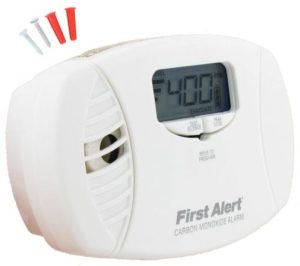Combustion byproducts in buildings come from heating appliances, automobiles, and tobacco smoke. This indoor pollution includes the poisonous gas such as carbon monoxide (CO), and tiny airborne particles such as soot. CO poisoning is the most common and serious combustion-safety hazard. However tobacco smoke is a leading cause of chronic respiratory diseases and lung cancer.
Carbon Monoxide (CO)
CO is a gaseous poison that comes from faulty combustion. CO is an odorless, poisonous gas that can cause sickness or death with little warning. It causes an estimated 400 deaths and 15,000 hospital visits each year in the U.S.
At low concentrations, CO poisoning causes flu-like symptoms including dizziness and exhaustion. At higher concentrations, CO poisoning causes impaired vision, headaches, confusion, and nausea. Continuous exposure to high CO levels causes fainting or death. Even doctors don’t always recognize the symptoms of CO poisoning.
Unvented space heaters, gas ovens, car exhaust, and tobacco smoke are the largest sources of CO. Many people suffer slight poisoning from CO every day from cigarettes, car exhaust, and faulty combustion devices. Remember, CO can kill you so assume that you are breathing CO if you smell combustion gases, and go outdoors immediately. CO poisoning reverses itself after the victim breathes enough fresh air. However, severe CO poisoning may require treatment in a barometric chamber at the hospital.
The Hazard of Smoke
Smoke is the second most dangerous hazard from combustion byproducts. Smoke particles settle deep in your lungs because they are very small, 2.5 microns or less (PM-2.5). Inside the lungs, these particles interfere with oxygen processing, irritate lung tissue, and can eventually destroy the lungs. PM-2.5 are considered the most dangerous type of particulate pollution.
Smoke is a major cause of these diseases.
- Asthma
- Lung cancer
- Emphysema
- Chronic bronchitis
Sources of Carbon Monoxide and Smoke
Occupants risk CO poisoning or chronic respiratory disease caused by smoke from combustion appliances in the home or if a family member smokes. Here are the leading sources of combustion-related indoor pollutants.
- Spillage from vented appliances such as wood stoves, wood fireplaces, gas furnaces, and gas space heaters. Visible soot on the exterior of a combustion appliance or on the horizontal surfaces of a home alert you to the presence of smoke and CO.
- Spillage from unvented space heaters, unvented gas fireplaces, gas ranges, and gas ovens.
- Smoking of tobacco products.
- Emission of automobile exhaust into attached garages or into the outdoor air near a home.
Advise building occupants to reduce health risks of CO and smoke by following these guidelines.
- Don’t use unvented gas space heaters, unvented gas fireplaces, or kerosene space heaters.
- Install an exhaust fan above gas ranges to vent combustion byproducts outdoors.
- Open the flue damper completely when using a gas or wood fireplace.
- Don’t warm up vehicles inside attached garages.
A heating technician should inspect and maintain combustion appliances every year or two. Heating technicians should look for spillage of combustion gases. They should measure combustion gases for CO during a service call, combustion-appliance replacement, weatherization project, or major renovation.
Carbon Monoxide and Smoke Alarms

Carbon-monoxide and smoke alarms are now common products that the building code requires in all new homes. These alarms wake occupants if the concentration of CO or smoke becomes dangerous. Building owners can buy combination alarms that sound an alarm or talk when they sense either CO or smoke.
Many CO alarms simply have a plug that plugs into a wall outlet. The best place for a smoke alarm or combination alarm is on the ceiling in the center of a room.